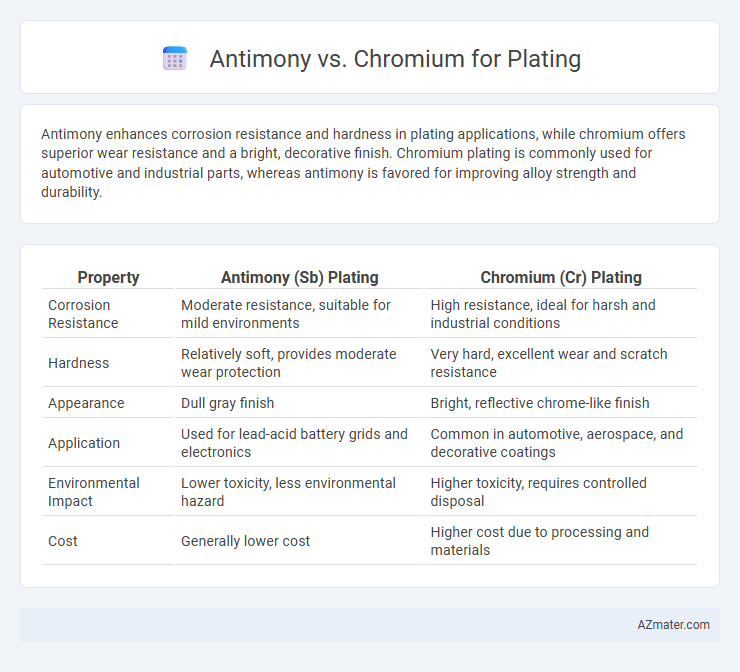Antimony enhances corrosion resistance and hardness in plating applications, while chromium offers superior wear resistance and a bright, decorative finish. Chromium plating is commonly used for automotive and industrial parts, whereas antimony is favored for improving alloy strength and durability.
Table of Comparison
| Property | Antimony (Sb) Plating | Chromium (Cr) Plating |
|---|---|---|
| Corrosion Resistance | Moderate resistance, suitable for mild environments | High resistance, ideal for harsh and industrial conditions |
| Hardness | Relatively soft, provides moderate wear protection | Very hard, excellent wear and scratch resistance |
| Appearance | Dull gray finish | Bright, reflective chrome-like finish |
| Application | Used for lead-acid battery grids and electronics | Common in automotive, aerospace, and decorative coatings |
| Environmental Impact | Lower toxicity, less environmental hazard | Higher toxicity, requires controlled disposal |
| Cost | Generally lower cost | Higher cost due to processing and materials |
Introduction to Metal Plating Technologies
Metal plating technologies utilize various elements to enhance material properties, with antimony and chromium serving distinct roles in the process. Antimony provides corrosion resistance and hardness when alloyed or used as an additive, commonly in lead-acid batteries or flame retardants, while chromium plating is renowned for its high corrosion resistance, hardness, and decorative finish on automotive, aerospace, and industrial components. Chromium's efficiency in creating a durable, wear-resistant layer makes it a preferred choice in electroplating, whereas antimony is less frequently used as a coating but valuable in metallurgical applications to improve metal alloys' mechanical properties.
Overview of Antimony: Properties and Applications
Antimony is a metalloid known for its hardness, brittleness, and resistance to corrosion, making it suitable for enhancing alloy strength and wear resistance in plating applications. Its chemical stability and ability to improve surface hardness are valuable in anticorrosive coatings and electrical contacts. Commonly used in flame retardants, semiconductors, and lead alloys, antimony's unique properties contribute to durable and protective metal finishes.
Chromium Plating: Key Characteristics
Chromium plating is prized for its exceptional hardness, corrosion resistance, and bright, reflective finish, making it ideal for decorative and industrial applications. Unlike antimony plating, chromium provides superior wear resistance and can withstand extreme temperatures, enhancing the durability of automotive, aerospace, and plumbing components. The process typically involves electroplating a thin layer of chromium onto metal surfaces, ensuring improved aesthetics and extended service life.
Comparison of Plating Processes: Antimony vs Chromium
Antimony plating offers superior corrosion resistance and a smoother finish compared to chromium plating, which is valued for its hardness and wear resistance. Chromium plating processes typically involve electroplating from a hexavalent chromium bath, whereas antimony plating utilizes electrolytic deposition often combined with other metals to enhance adhesion. While chromium provides a bright, reflective surface ideal for decorative and protective applications, antimony's unique properties make it preferred in specialized industrial contexts requiring chemical stability and electrical conductivity.
Durability and Corrosion Resistance
Antimony plating offers moderate durability and corrosion resistance, making it suitable for applications requiring lightweight protection against wear and oxidation. Chromium plating, renowned for its exceptional hardness and resistance to corrosion, significantly extends the lifespan of components exposed to harsh environments and frequent contact. The superior durability and corrosion resistance of chromium make it the preferred choice for automotive parts, industrial machinery, and decorative finishes where long-lasting performance is critical.
Aesthetic and Finish Differences
Antimony plating produces a smooth, shiny finish with a silver-white appearance that enhances corrosion resistance and provides a decorative luster suited for jewelry and vintage restorations. Chromium plating delivers a highly reflective, mirror-like surface with superior hardness and wear resistance, often used in automotive and industrial applications for its bright, durable finish. The aesthetic difference lies in antimony's warmer, softer sheen compared to chromium's colder, more reflective chrome-like brilliance.
Environmental and Health Considerations
Antimony plating poses fewer environmental hazards compared to chromium, as antimony compounds exhibit lower toxicity and reduced potential for groundwater contamination. Chromium plating, particularly hexavalent chromium, is highly toxic and carcinogenic, with stringent regulations due to its significant health risks including respiratory issues and skin ulcers. Waste management and disposal protocols are critical for chromium plating processes to minimize environmental impact and ensure worker safety.
Cost Analysis: Antimony vs Chromium
Antimony plating generally costs less than chromium plating due to lower raw material prices and simplified processing requirements. Chromium plating involves higher expenses driven by the need for specialized equipment and environmental controls to manage toxic hexavalent chromium emissions. Cost analysis reveals antimony as a budget-friendly alternative for decorative and protective coatings, while chromium's durability and corrosion resistance justify its premium price in industrial applications.
Industrial and Commercial Uses
Antimony enhances corrosion resistance and hardness when alloyed with metals in industrial plating, making it ideal for electrical connectors and battery components. Chromium plating provides superior wear resistance, aesthetic appeal, and oxidation protection, widely used in automotive parts, machinery, and decorative finishes. Both metals serve critical roles in commercial plating, with chromium favored for its durability and antimony valued for its anti-friction properties.
Choosing the Right Plating Metal: Factors to Consider
When choosing between antimony and chromium for plating, consider factors such as corrosion resistance, hardness, and application environment. Chromium offers superior hardness and wear resistance, making it ideal for decorative and protective coatings on automotive parts and tools. Antimony, often used as an alloying element, enhances the mechanical properties of base metals but is less common as a plating metal, so its utility depends on the specific performance requirements and cost considerations.

Infographic: Antimony vs Chromium for Plating
 azmater.com
azmater.com